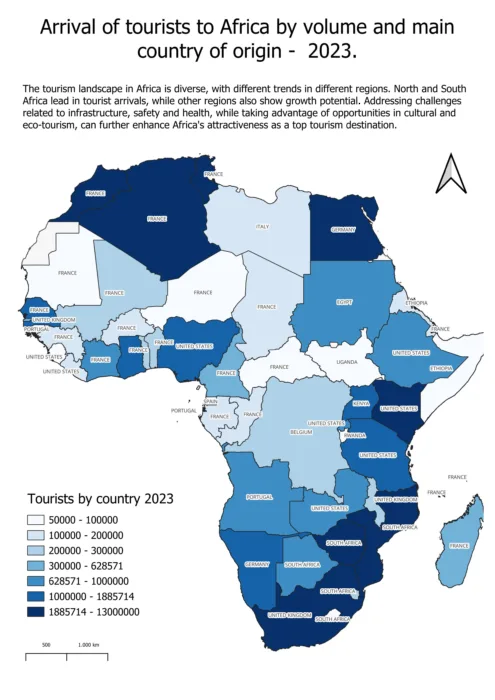Tourism in Africa: where do they come from? .This article provides an analysis of tourism trends in African countries, focusing on the number of tourists received in 2023 and their countries of origin. The study aims to understand the underlying patterns and factors influencing these trends.
Introduction
Tourism is a critical sector for many African economies, significantly contributing to GDP, job creation, and foreign exchange earnings. This study analyzes tourist arrival data from various African countries in 2023, identifying primary source markets and regional variations. Understanding these patterns is essential for policymakers, businesses, and stakeholders aiming to enhance the tourism industry in Africa.
Methodology
The data for this study were collected from national tourism boards, international travel reports, and statistical agencies. The key metrics analyzed include the number of tourists received by each country in 2023 and their main countries of origin.
Results
The table below summarizes the number of tourists received by various African countries in 2023 and their primary countries of origin.
| ISO Code | Country Name | Number of Tourists Received in 2023 | Main Origin of Tourists |
|---|---|---|---|
| DZA | Algeria | 3,000,000 | France |
| AGO | Angola | 800,000 | Portugal |
| BEN | Benin | 300,000 | France |
| BWA | Botswana | 1,000,000 | South Africa |
| BFA | Burkina Faso | 200,000 | France |
| BDI | Burundi | 100,000 | Rwanda |
| CPV | Cape Verde | 800,000 | Portugal |
| CMR | Cameroon | 600,000 | France |
| CAF | Central African Republic | 50,000 | France |
| TCD | Chad | 200,000 | France |
| COM | Comoros | 50,000 | France |
| COD | Democratic Republic of the Congo | 300,000 | Belgium |
| COG | Republic of the Congo | 200,000 | France |
| CIV | Ivory Coast | 700,000 | France |
| DJI | Djibouti | 200,000 | France |
| EGY | Egypt | 11,000,000 | Germany |
| GNQ | Equatorial Guinea | 100,000 | Spain |
| ERI | Eritrea | 150,000 | Ethiopia |
| SWZ | Eswatini | 300,000 | South Africa |
| ETH | Ethiopia | 1,000,000 | United States |
| GAB | Gabon | 200,000 | France |
| GMB | Gambia | 400,000 | United Kingdom |
| GHA | Ghana | 1,200,000 | United States |
| GIN | Guinea | 200,000 | France |
| GNB | Guinea-Bissau | 50,000 | Portugal |
| KEN | Kenya | 2,500,000 | United States |
| LSO | Lesotho | 100,000 | South Africa |
| LBR | Liberia | 200,000 | United States |
| LBY | Libya | 200,000 | Italy |
| MDG | Madagascar | 400,000 | France |
| MWI | Malawi | 300,000 | United Kingdom |
| MLI | Mali | 250,000 | France |
| MRT | Mauritania | 100,000 | France |
| MUS | Mauritius | 1,300,000 | France |
| MAR | Morocco | 13,000,000 | France |
| MOZ | Mozambique | 2,200,000 | South Africa |
| NAM | Namibia | 1,600,000 | Germany |
| NER | Niger | 100,000 | France |
| NGA | Nigeria | 1,500,000 | United States |
| RWA | Rwanda | 1,000,000 | United States |
| STP | São Tomé and Príncipe | 50,000 | Portugal |
| SEN | Senegal | 1,200,000 | France |
| SYC | Seychelles | 400,000 | France |
| SLE | Sierra Leone | 100,000 | United States |
| SOM | Somalia | 50,000 | Ethiopia |
| ZAF | South Africa | 10,000,000 | United Kingdom |
| SSD | South Sudan | 50,000 | Uganda |
| SDN | Sudan | 800,000 | Egypt |
| SWZ | Eswatini | 300,000 | South Africa |
| TZA | Tanzania | 1,800,000 | United States |
| TGO | Togo | 300,000 | France |
| TUN | Tunisia | 7,500,000 | France |
| UGA | Uganda | 1,500,000 | Kenya |
| ZMB | Zambia | 900,000 | United States |
| ZWE | Zimbabwe | 2,000,000 | South Africa |
Regional Analysis
North Africa: North African countries, particularly Morocco and Egypt, are among the top recipients of tourists in 2023. Morocco leads with 13 million tourists, primarily from France, reflecting its historical and cultural ties with the country. Egypt follows with 11 million tourists, with Germany being the main source, likely due to the historical interest in Egypt’s ancient civilizations. Tunisia also stands out with 7.5 million tourists, mainly from France, indicating its appeal as a Mediterranean destination. Key destinations in these countries include the following:
- Morocco: Marrakech, Casablanca, Fez, and the Atlas Mountains.
- Egypt: Cairo, Giza Pyramids, Luxor, and the Red Sea resorts.
- Tunisia: Tunis, Carthage, Sousse, and Djerba.
West Africa: In West Africa, Ghana and Senegal stand out with 1.2 million tourists each. The United States is the primary source of tourists for Ghana, indicative of the growing diaspora tourism, while Senegal attracts mainly French tourists. Nigeria, with 1.5 million tourists from the United States, shows significant potential, driven by business and cultural connections. Key destinations include:
- Ghana: Accra, Cape Coast Castle, Kumasi, and Mole National Park.
- Senegal: Dakar, Gorée Island, Saint-Louis, and the Saloum Delta.
- Nigeria: Lagos, Abuja, Yankari National Park, and Olumo Rock.
East Africa: Kenya and Tanzania are the leading East African destinations, with Kenya receiving 2.5 million tourists and Tanzania 1.8 million, both primarily from the United States. This reflects the strong appeal of East African wildlife and safaris to American tourists. Ethiopia also attracts a notable number of tourists, with 1 million visitors mainly from the United States, highlighting its cultural and historical attractions. Key destinations include:
- Kenya: Maasai Mara, Nairobi, Mombasa, and Amboseli National Park.
- Tanzania: Serengeti National Park, Mount Kilimanjaro, Zanzibar, and Ngorongoro Crater.
- Ethiopia: Addis Ababa, Lalibela, Gondar, and the Simien Mountains.
Southern Africa: South Africa dominates the Southern African region with 10 million tourists, mainly from the United Kingdom, highlighting its diverse attractions from wildlife to urban experiences. Namibia and Botswana also attract significant numbers of tourists, with Germany and South Africa being the main origins respectively. Zimbabwe, with 2 million tourists, primarily from South Africa, showcases the regional tourism dynamics. Key destinations include:
- South Africa: Cape Town, Kruger National Park, Johannesburg, and the Garden Route.
- Namibia: Etosha National Park, Sossusvlei, Swakopmund, and Fish River Canyon.
- Botswana: Okavango Delta, Chobe National Park, Gaborone, and the Kalahari Desert.
- Zimbabwe: Victoria Falls, Hwange National Park, Harare, and Matobo National Park.
Central Africa: Central African countries generally receive fewer tourists, with the Democratic Republic of the Congo and Cameroon being notable exceptions, primarily attracting visitors from Belgium and France respectively. The lower tourist numbers in this region can be attributed to political instability and lack of infrastructure. Key destinations include:
- Democratic Republic of the Congo: Kinshasa, Virunga National Park, Kahuzi-Biega National Park, and the Congo River.
- Cameroon: Yaoundé, Douala, Waza National Park, and Mount Cameroon.
Economic Implications
Tourism has significant economic implications for African countries. For instance, countries like Morocco and Egypt rely heavily on tourism for foreign exchange and employment. The influx of tourists from Western countries, particularly France, Germany, and the United States, indicates strong economic ties and potential for further growth in tourism-related sectors.
Challenges and Opportunities
Challenges:
- Infrastructure: Many African countries still face challenges with infrastructure, which can hinder the growth of tourism. Improving transportation, accommodation, and other facilities is crucial.
- Security: Political instability and security issues in certain regions deter potential tourists. Efforts to enhance safety and stability are necessary to attract more visitors.
- Health Risks: Health concerns, such as outbreaks of diseases, can negatively impact tourism. Strengthening healthcare systems and ensuring the safety of tourists is vital.
Opportunities:
- Cultural Tourism: Promoting the rich cultural heritage of African countries can attract more tourists interested in history and traditions.
- Eco-Tourism: Africa’s diverse ecosystems and wildlife offer vast potential for eco-tourism, attracting environmentally conscious travelers.
- Diaspora Tourism: Leveraging the connection with the African diaspora, particularly in the United States and Europe, can significantly boost tourist numbers.
Then …
The tourism landscape in Africa is diverse, with varying trends across different regions. North and Southern Africa lead in tourist arrivals, while other regions also show potential for growth. Addressing challenges related to infrastructure, security, and health, while capitalizing on opportunities in cultural and eco-tourism, can further enhance Africa’s appeal as a top tourist destination.
Recommendations
- Investment in Infrastructure: Governments and private sectors should invest in improving infrastructure to provide a better experience for tourists.
- Marketing and Promotion: Enhanced marketing efforts, particularly targeting the diaspora and eco-tourism markets, can attract more visitors.
- Policy and Regulation: Implementing supportive policies and regulations that ensure safety, quality, and sustainability in tourism.
Sources
The data for this study were sourced from national tourism boards, international travel reports, and statistical agencies. The primary sources include:
- World Travel & Tourism Council (WTTC)
- United Nations World Tourism Organization (UNWTO)
- National tourism boards of respective African countries
By understanding the current tourism trends and addressing the identified challenges, African countries can enhance their attractiveness to international tourists and drive sustainable economic growth in the sector.

Team Prodafrica
team@prodafrica.com
